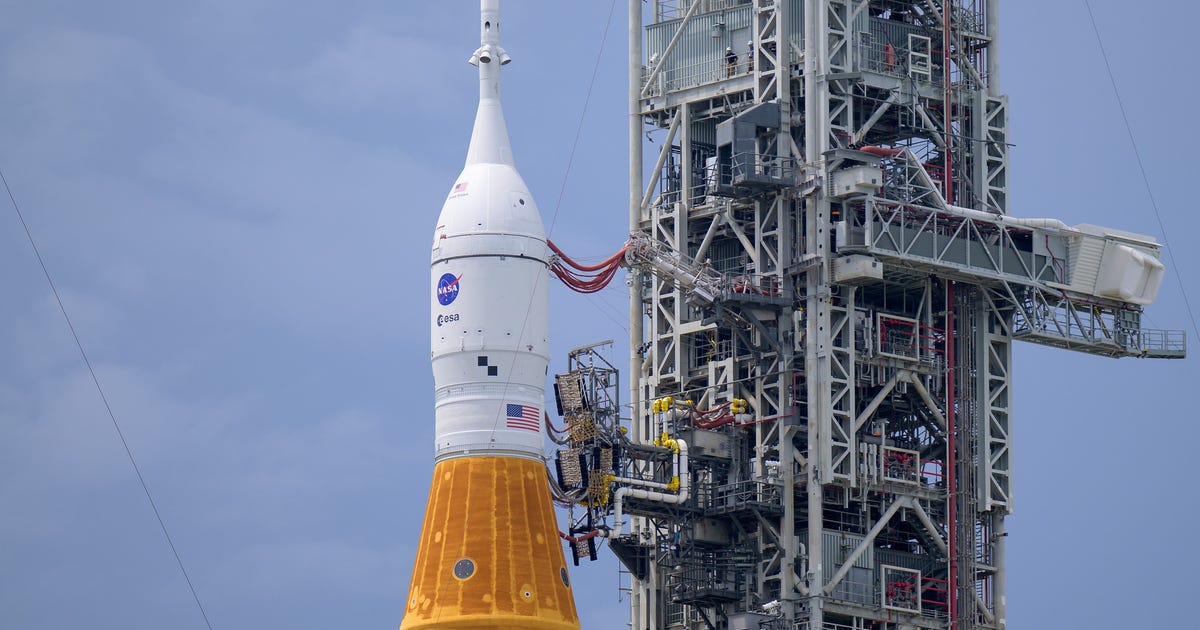
Artemis I, the first mission in NASA’s ambitious program to get humans back to the moon, suffered an engine setback just hours before liftoff Monday morning, forcing the highly anticipated launch to be scrubbed. Now, the space agency is looking at a backup window that opens on Friday, Sept. 2, at 9:48 a.m. PT (12:48 p.m. ET, 5:48 p.m. BST), but there’s still some uncertainty on that front.
“To summarize, we held at T-minus 40 minutes and counting after the team was unable to get past an engine bleed that didn’t show the right temperature once they got into the engine bleed test,” NASA said as part of its scrub announcement on Monday. “Ultimately the launch director has called a scrub for the day. The earliest opportunity, depending on what happens with this engine, would be Sept. 2, that is available to the launch team, however we will await a determination”
During a late-afternoon press conference on Monday, Artemis mission manager Mike Sarafin emphasized that until a formal meeting about today’s events occurs, currently scheduled for Tuesday as the team takes a well-deserved rest after a hectic morning, it’s hard to tell what’s in store for Artemis I going forward.
To put it simply, Sarafin said there’s a “non-zero chance” of activities restarting on Friday — but also of the rocket being rolled back off the pad for a closer look. “If we can resolve this operationally out of the pad, there won’t be any need for that. And if we can resolve this operationally out at the pad in the next 48 hours; 72 hours, Friday’s definitely in play,” Sarafin said. “We need the team to digest what we’ve learned and we’ll take it from there.”
The culprit is engine 3
After a brief weather delay on Monday, things looked on track for Artemis I’s bright orange Space Launch System rocket, but a couple of technical hurdles arose during its fuel loading stage. On top of that, earlier in the day, NASA noted there was a “crack” in the thermal protection system material on one of the SLS core stage flanges, but it was later revealed to be a consequence of the super-chilled propellant, not a structural issue.
With regard to engines, as the rocket’s boosters were being filled with liquid oxygen, NASA engineers noted that engine 3 was “not properly being conditioned through the bleed process.” This process is meant to allow the engines to chill to the right temperature by releasing a small amount of the fuel. It wasn’t working.
Back in June, at the time of Artemis I’s wet dress rehearsal — which took four tries to complete — the team hoped to examine the efficacy of exactly this bleed process, but didn’t get to it. “This is something they wanted to test during wet dress four but were unable to,” NASA broadcaster Derrol Nail said during the agency’s livestream of the launch attempt. “So this was the first opportunity for the team to see this live in action. It’s a particularly tricky issue to get that temperature dialed in.”
About an hour after trying to troubleshoot the engine 3 bleed problem, the team met with launch director Charlie Blackwell-Thompson to discuss how to move forward. “Right now, the indications don’t point to an engine problem,” Sarafin said, meaning the setback likely isn’t tied to the engine interface itself. “It’s in the the bleed system that thermally conditions the engines.”
Nonetheless, Artemis I’s launch was officially scrubbed.
“It’s just part of the space business — and particularly a test flight,” NASA Administrator Bill Nelson said after the delay was announced on Monday. “We are stressing and testing this rocket and spacecraft in a way that you would never do it with the human crew on board. That’s the purpose of a test flight.”
